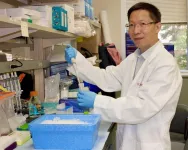Ubiquitous wireless technologies like Wi-Fi, Bluetooth, and 5G rely on radio frequency (RF) signals to send and receive data. A new prototype of an energy harvesting module – developed by a team led by scientists from the National University of Singapore (NUS) – can now convert ambient or ‘waste’ RF signals into direct current (DC) voltage. This can be used to power small electronic devices without the use of batteries.
RF energy harvesting technologies, such as this, is essential as they reduce battery dependency, extend device lifetimes, minimise environmental impact, and enhance the feasibility of wireless sensor networks and IoT devices in remote areas where frequent battery replacement is impractical.
However, RF energy harvesting technologies face challenges due to low ambient RF signal power (typically less than -20 dBm), where current rectifier technology either fails to operate or exhibits a low RF-to-DC conversion efficiency. While improving antenna efficiency and impedance matching can enhance performance, this also increases on-chip size, presenting obstacles to integration and miniaturisation.
To address these challenges, a team of NUS researchers, working in collaboration with scientists from Tohoku University (TU) in Japan and University of Messina (UNIME) in Italy, has developed a compact and sensitive rectifier technology that uses nanoscale spin-rectifier (SR) to convert ambient wireless radio frequency signals at power less than -20 dBm to a DC voltage.
The team optimised SR devices and designed two configurations: 1) a single SR-based rectenna operational between -62 dBm and -20 dBm, and 2) an array of 10 SRs in series achieving 7.8% efficiency and zero-bias sensitivity of approximately 34,500 mV/mW. Integrating the SR-array into an energy harvesting module, they successfully powered a commercial temperature sensor at -27 dBm.
“Harvesting ambient RF electromagnetic signals is crucial for advancing energy-efficient electronic devices and sensors. However, existing Energy Harvesting Modules face challenges operating at low ambient power due to limitations in existing rectifier technology,” explained Professor Yang Hyunsoo from the Department of Electrical and Computer Engineering at the NUS College of Design and Engineering, who spearheaded the project.
Prof Yang added, “For example, gigahertz Schottky diode technology has remained saturated for decades due to thermodynamic restrictions at low power, with recent efforts focused only on improving antenna efficiency and impedance-matching networks, at the expense of bigger on-chip footprints. Nanoscale spin-rectifiers, on the other hand, offer a compact technology for sensitive and efficient RF-to-DC conversion.”
Elaborating on the team’s breakthrough technology, Prof Yang said, “We optimised the spin-rectifiers to operate at low RF power levels available in the ambient, and integrated an array of such spin-rectifiers to an energy harvesting module for powering the LED and commercial sensor at RF power less than -20 dBm. Our results demonstrate that SR-technology is easy to integrate and scalable, facilitating the development of large-scale SR-arrays for various low-powered RF and communication applications.”
The experimental research was carried out in collaboration with Professor Shunsuke Fukami and his team from TU, while the simulation was carried out by Professor Giovanni Finocchio from UNIME. The results were published in the prestigious journal, Nature Electronics, on 24 July 2024.
Spin-rectifier-based technology for the low-power operation
State-of-the-art rectifiers (Schottky diodes, tunnel diodes and two-dimensional MoS2), have reached efficiencies of 40–70% at Prf ≥ -10 dBm. However, the ambient RF power available from the RF sources such as Wi-Fi routers is less than -20 dBm. Developing high-efficiency rectifiers for low-power regimes (Prf < -20 dBm) is difficult due to thermodynamic constraints and high-frequency parasitic effects. Additionally, on-chip rectifiers require an external antenna and impedance-matching circuit, impeding on-chip scaling. Therefore, designing a rectifier for an Energy Harvesting Module (EHM) that is sensitive to ambient RF power with a compact on-chip design remains a significant challenge.
The nanoscale spin-rectifiers can convert the RF signal to a DC voltage using the spin-diode effect. Although the SR-based technology surpassed the Schottky diode sensitivity, the low-power efficiency is still low (< 1%). To overcome the low-power limitations, the research team studied the intrinsic properties of SR, including the perpendicular anisotropy, device geometry, and dipolar field from the polarizer layer, as well as the dynamic response, which depends on the zero-field tunnelling magnetoresistance and voltage-controlled magnetic anisotropy (VCMA). Combining these optimised parameters with the external antenna impedance-matched with a single SR, the researcher designed ultralow power SR-rectenna.
To improve output and achieve on-chip operation, the SRs were coupled in an array arrangement, with the small co-planar waveguides on the SRs employed to couple RF power, resulting in compact on-chip area and high efficiency. One of the key findings is that the self-parametric effect driven by well-known VCMA in magnetic tunnel junctions-based spin-rectifiers significantly contributes to the low-power operation of SR-arrays, while also enhancing their bandwidth and rectification voltage. In a comprehensive comparison with Schottky diode technology in the same ambient situation and from previous literature assessment, the research team discovered that SR-technology might be the most compact, efficient, and sensitive rectifier technology.
Commenting on the significance of their results, Dr Raghav Sharma, the first author of the paper, shared, “Despite extensive global research on rectifiers and energy harvesting modules, fundamental constraints in rectifier technology remain unresolved for low ambient RF power operation. Spin-rectifier technology offers a promising alternative, surpassing current Schottky diode efficiency and sensitivity in low-power regime. This advancement benchmarks RF rectifier technologies at low power, paving the way for designing next-generation ambient RF energy harvesters and sensors based on spin-rectifiers.”
Next steps
The NUS research team is now exploring the integration of an on-chip antenna to improve the efficiency and compactness of SR technologies. The team is also developing series-parallel connections to tune impedance in large arrays of SRs, utilising on-chip interconnects to connect individual SRs. This approach aims to enhance the harvesting of RF power, potentially generating a significant rectified voltage of a few volts, thus eliminating the need for a DC-to-DC booster.
The researchers also aim to collaborate with industry and academic partners for the advancement of self-sustained smart systems based on on-chip SR rectifiers. This could pave the way for compact on-chip technologies for wireless charging and signal detection systems.
END




